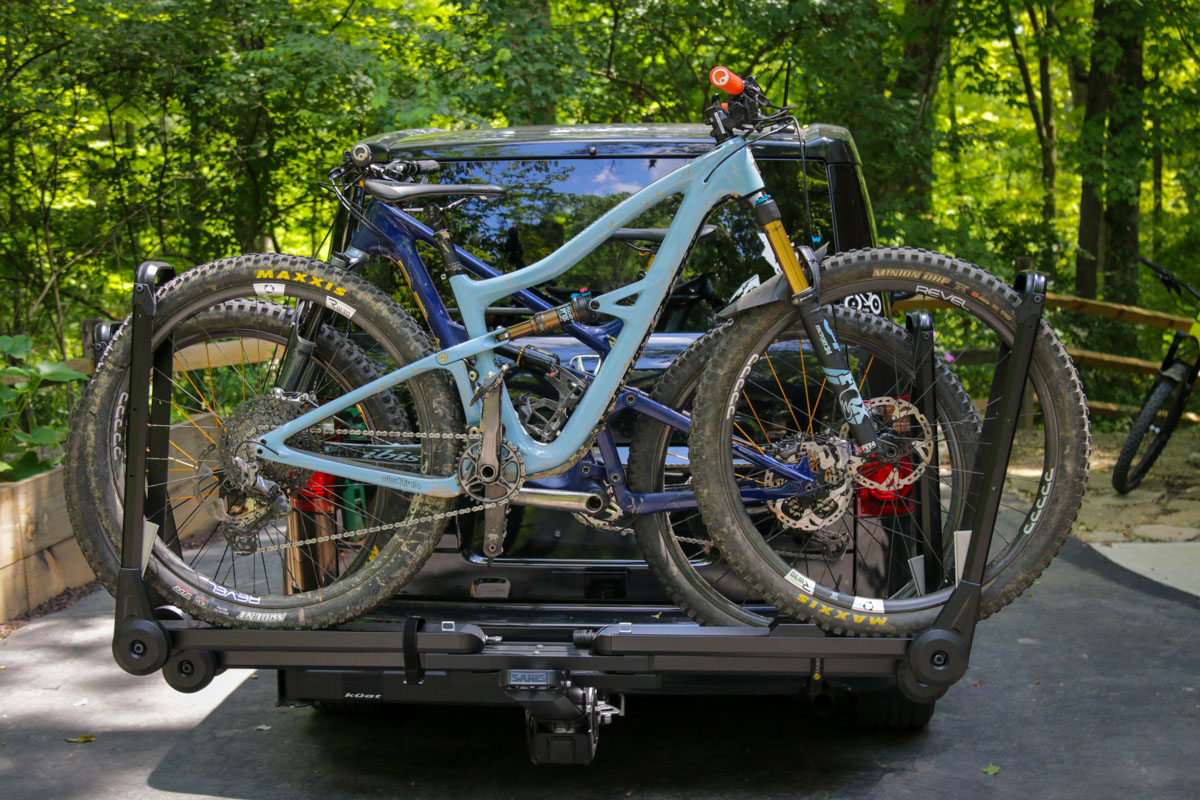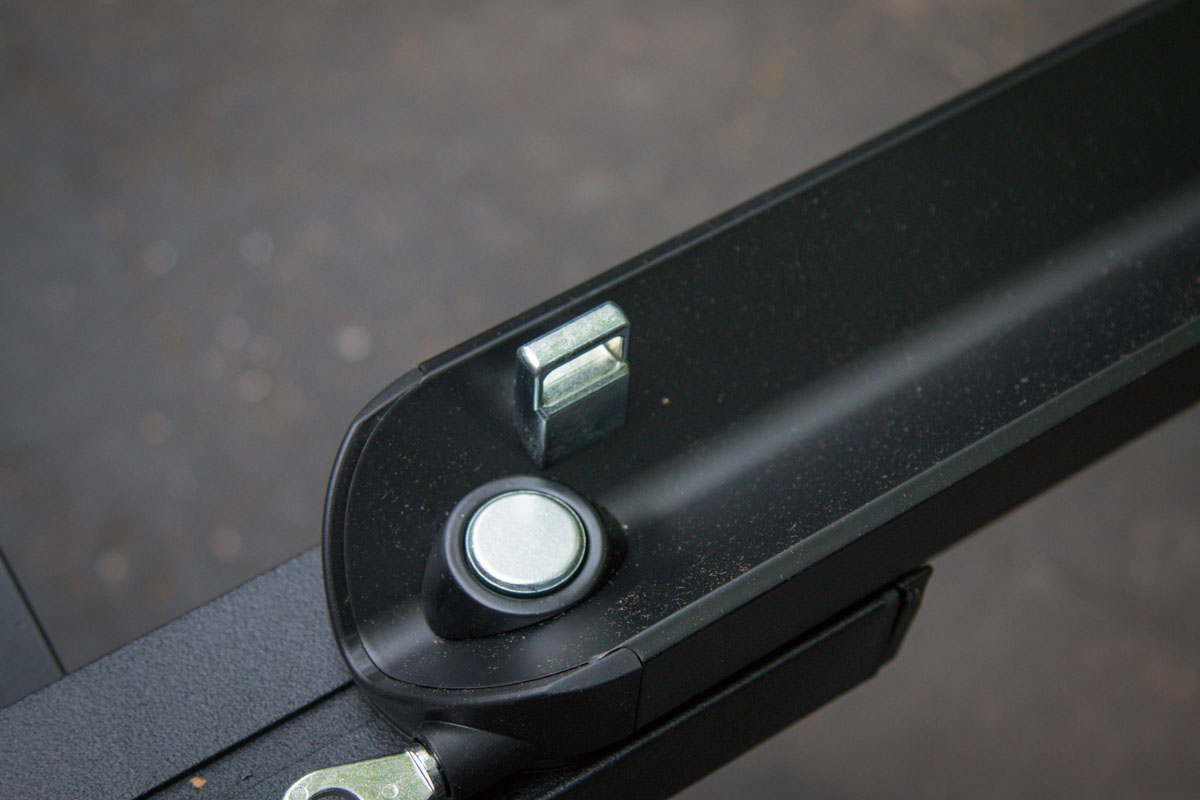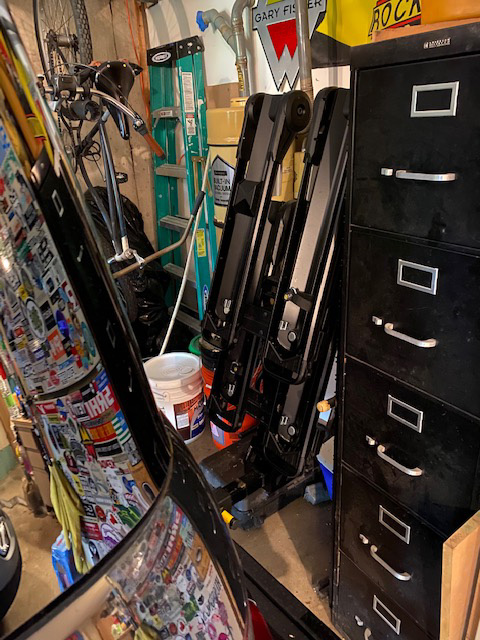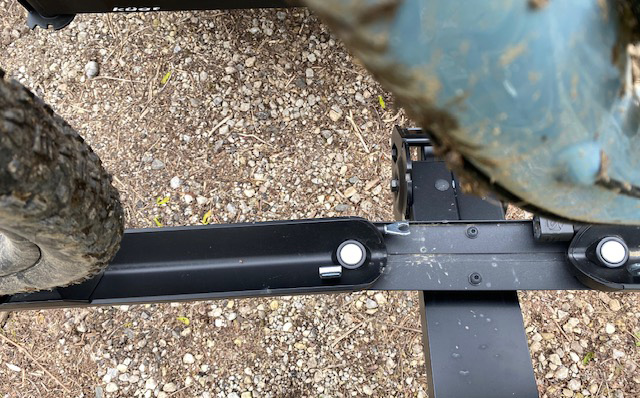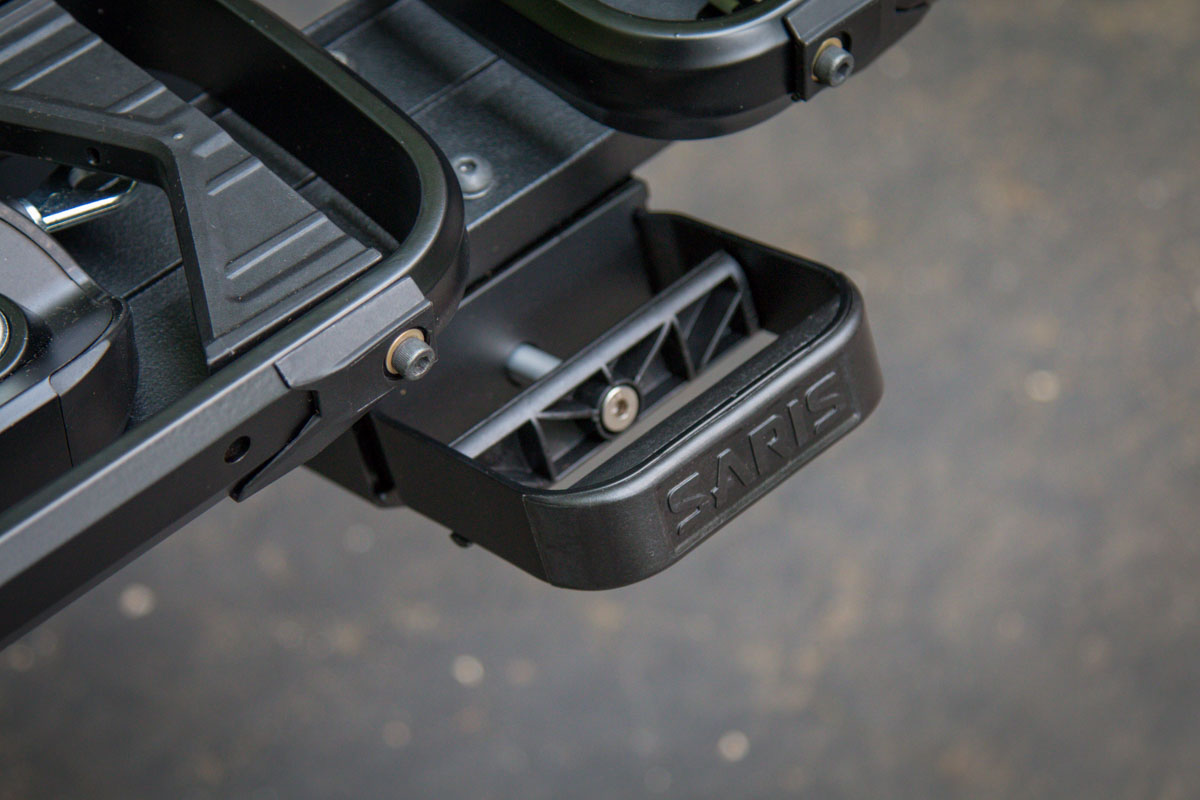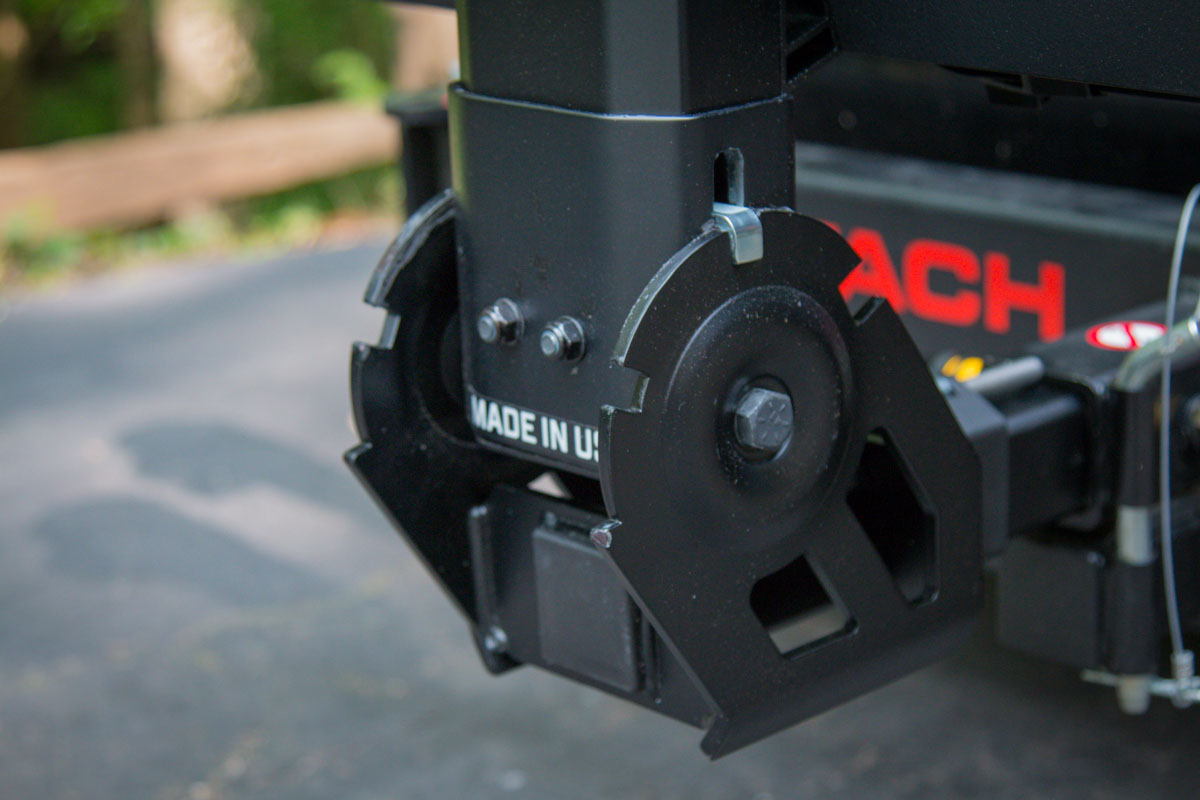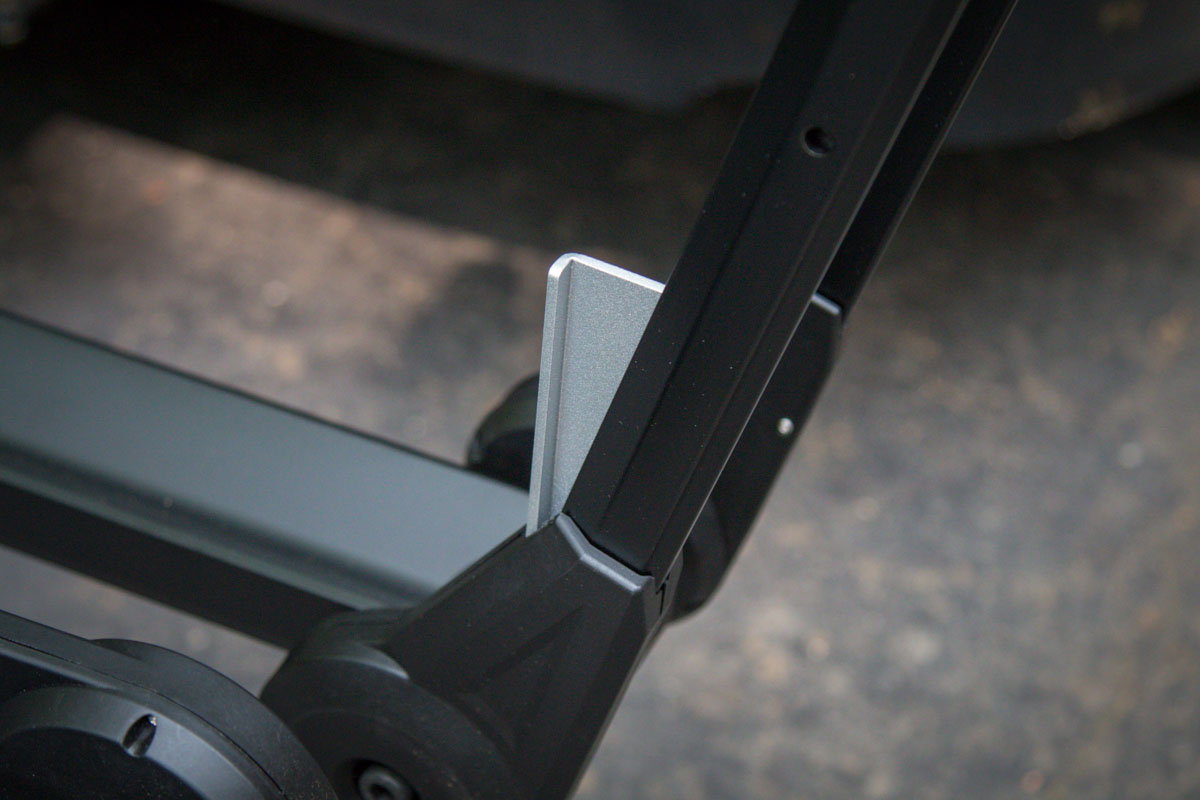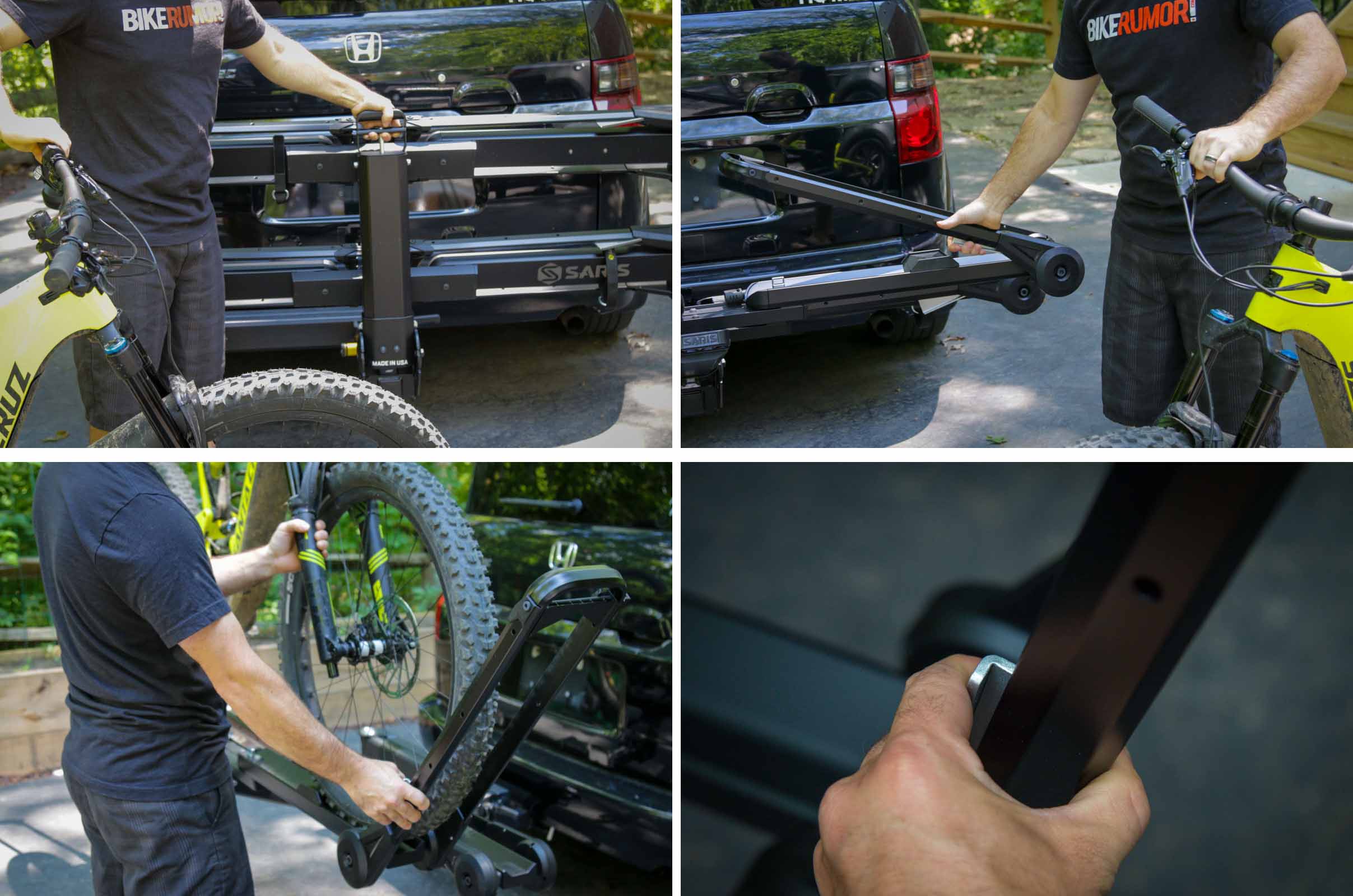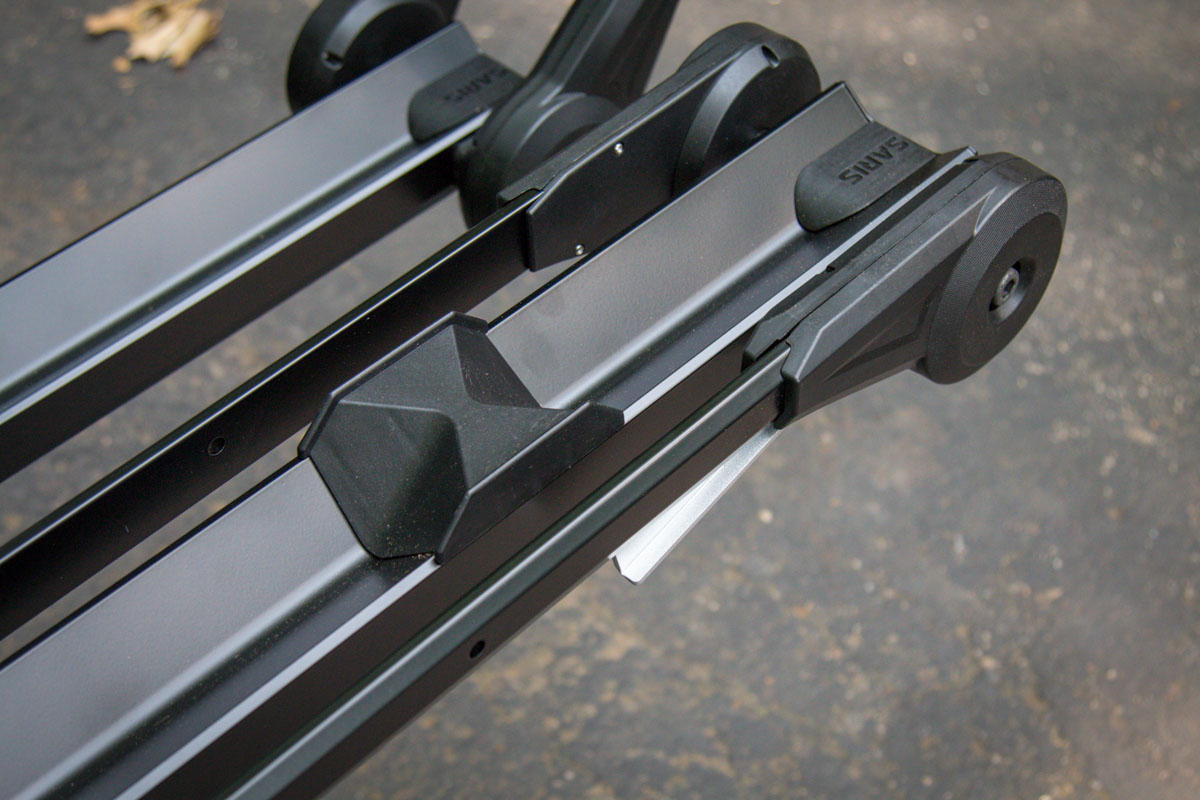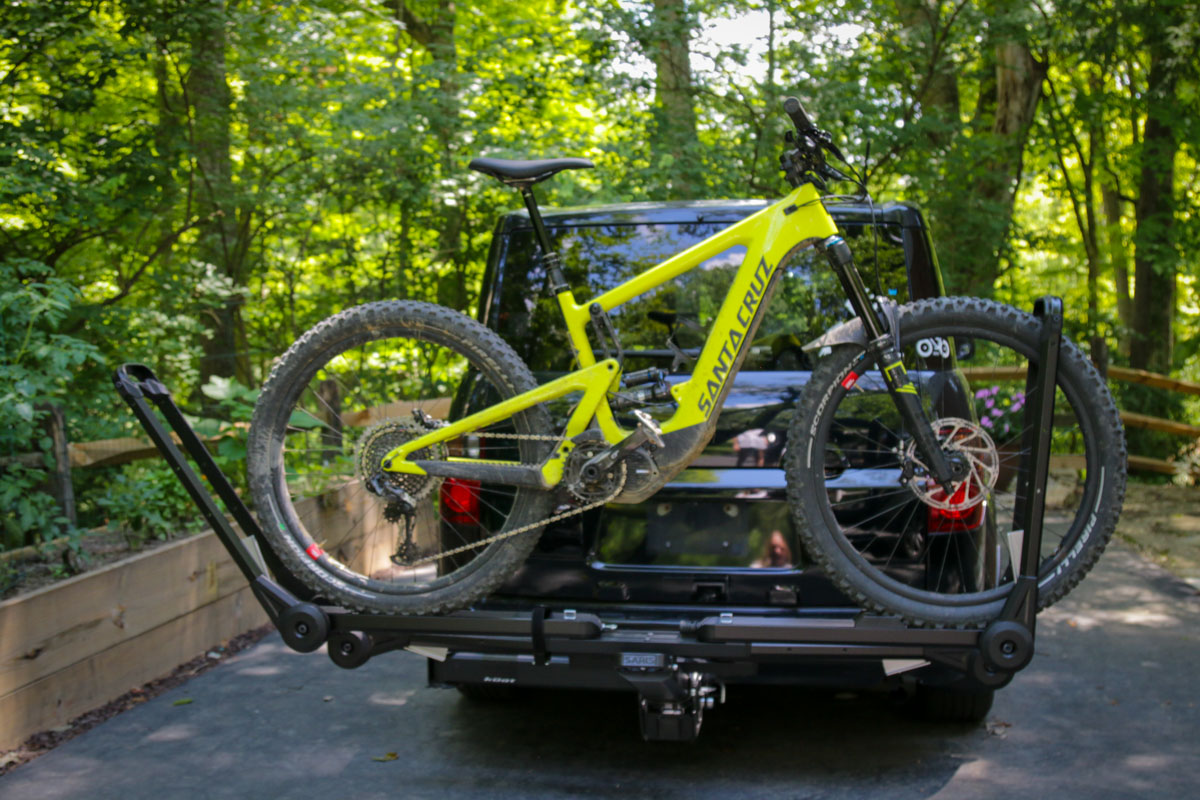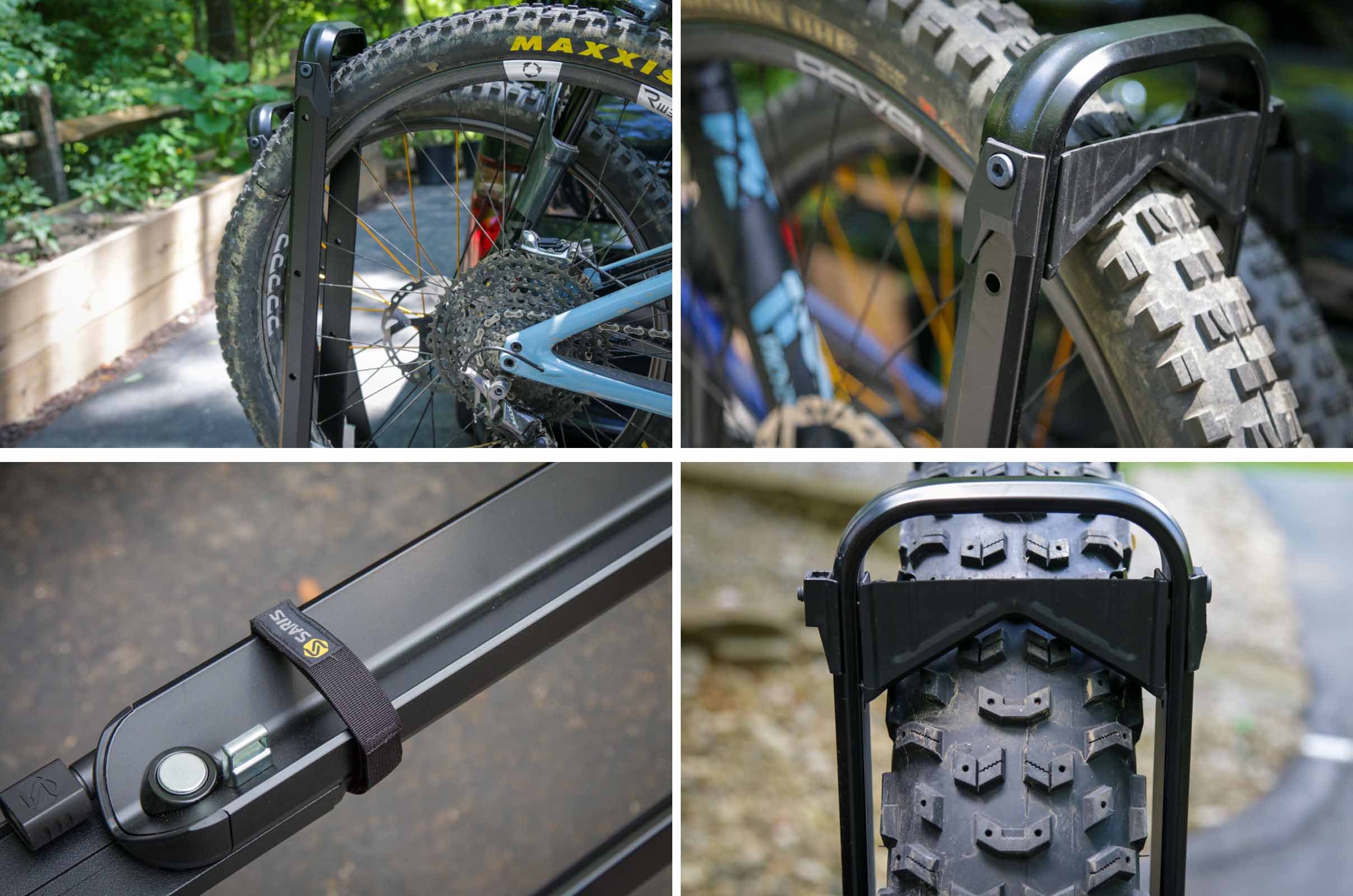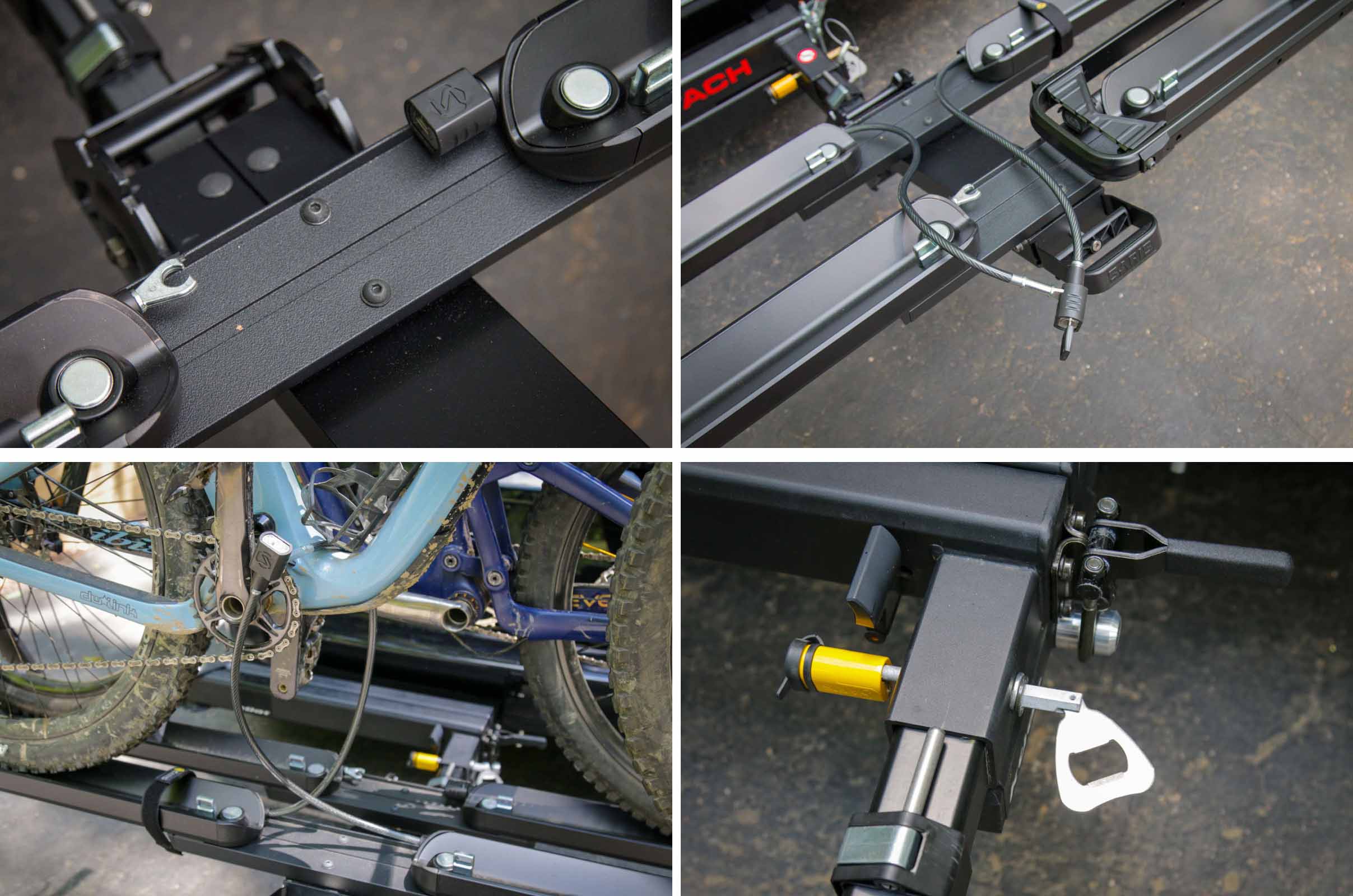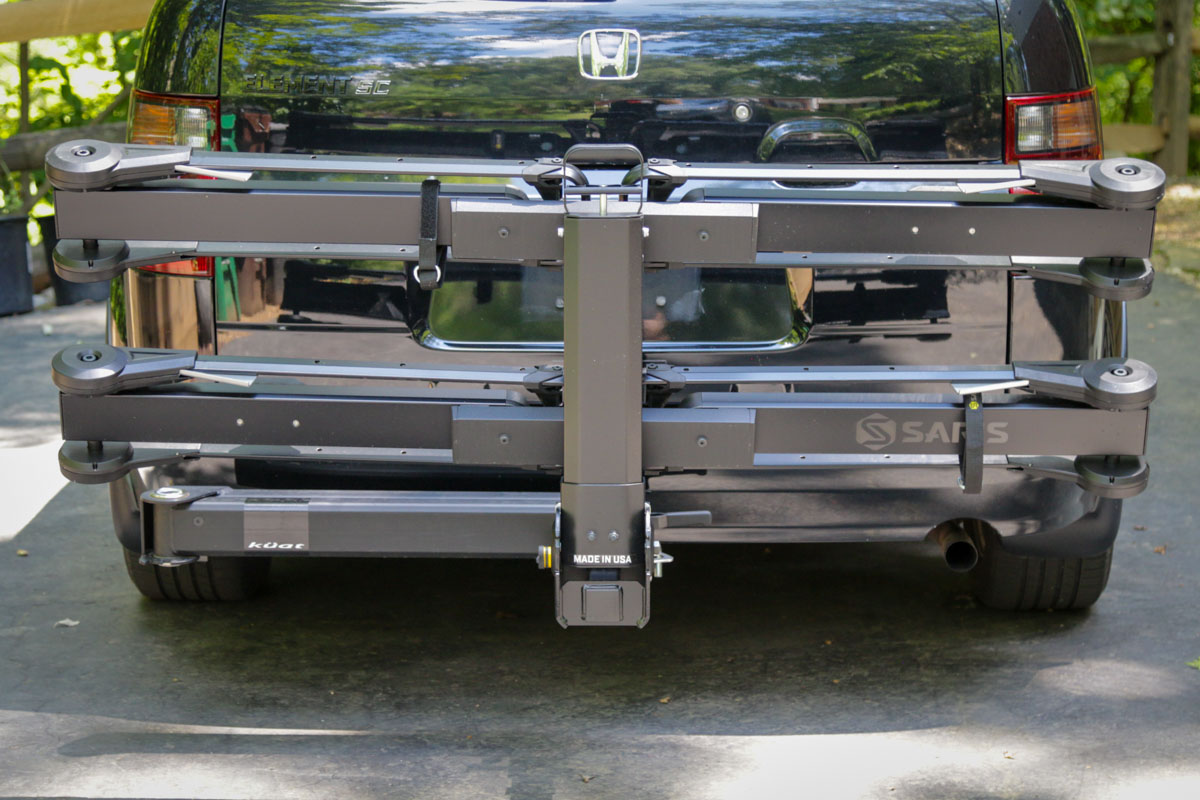I don’t have the data to back this up, but I would bet money that people who own bike racks that are easier to use, end up riding their bikes more. That may not be true for the hard core cyclist who tries to ride every day, but for families juggling 10 other things, the ability to slap the bikes on the car in seconds and head out for a quick ride could make or break the day. And when it comes to bike racks, it doesn’t get much easier than the tray-style hitch rack.
The bikes are low to the ground so you don’t have to lift them high, and the individual trays mean that you aren’t playing bike-Tetris to get four bikes to fit on a “four bike rack.” Over the years, tray-style racks have evolved, largely pioneered by 1UP. However, when the patent on their original Quik-Rack expired in 2015, that seems to have opened the door for other companies to come up with similar designs. And while the Saris MTR may look similar in concept to 1UP racks, there are a number of features that make it stand out and easier to use.
Assembly
When you get your MTR, it will come nearly fully assembled in a giant and very heavy box. The Rack itself weighs 55lbs, and add a few more for the packaging. For full disclosure, I’ve had to assemble three of these racks now (I’ll get to why in a minute), and the first rack showed up looking a bit rough. Some of the powder coat was chipped, and some plastic bits were cracked. BUT, I can say that rack #2 and #3 were much better in terms of their condition on arrival. It seems that Saris may have had a few issues with the very first batch, but has since improved.
To build the MTR, essentially all that is needed is to slide the rack into your hitch, install the hitch pin which is threaded and now includes a tool-free handle that doubles as a bottle opener, and then tilt the rack down and install the end cap with the integrated allen-wrench storage. With the anti-wobble mechanism captured in the rack, it’s easy to tighten the rack down without any tools.
Once the rack is installed, and the hitch pin is through the hole, you can set the rack depth gauge (similar to the 1UP Hitch Bar Stop). This adjustable post will help you quickly install the rack in the future – no need to get down on the ground to see if you’ve lined up the hole properly. Just install the rack until the post touches your hitch, and you know that it’s in the perfect spot. Definitely a nice touch.
Once the rack is installed, you’ll need to tilt the arms down to use it. The rack ships with all of the arms in the up position, so to lower them you pull on the silver rectangular tab above and swivel the arm until it snaps into the extended position.
More than just for shipping, the ability to fold up the arms is actually pretty handy. It’s a tight squeeze to get my car in the garage, and I usually can’t do it f there is a hitch rack installed (especially not with a hitch rack and swing away adapter). However, since the MTR arms fold up, I was able to squeeze it in between obstacles and get the door closed.
Also, if you find yourself driving with the rack installed but with no bikes on it, folding them up actually had a noticeable impact on fuel economy. At least for me on the Element, I noticed a 1-2mpg improvement per tank when going back and forth between arms up and arms down.
This feature is also the reason I have now tested three different MTR racks. On Rack #1, the arms were pretty loose, and had enough play that they would move a bit with a bike installed. It never made a bike come loose, but it’s also not ideal. On Rack #2, the arms were a bit tighter but still moved, and Rack #3 has been the best yet with the arms taking far more force to pivot. It seems that by the time Rack #3 had rolled off the assembly line, Saris had tightened up the tolerances of the locking pin, locating hole, and pivot.
I’ve put a lot of miles on all of the racks, but especially #3, and it seems that the issue is mostly solved. Though I do think this could be improved upon further for the next generation, maybe with dual locking pins or something.
One Handed Operation
So where does the MTR really stand out? For starters, anything you have to operate to load a bike is designed so that it can be done one-handed. Starting with the tilt feature of the rack, the wide, ergonomic handle can be operated with one hand to lower the rack to the flat position, or down further to access the trunk. Note that it’s right out in front and easy to access – even if you add the 1 or 2 bike add-ons. Just like it should be (It’s only fair to point out that 1UP’s tilt handle has been drastically improved with their new Equip-D version).
The same can be said for the wheel support uprights. Grab the silver release, and you can pivot the arm with the same hand. Why does that matter? It means that you can hold the bike up with one hand, and operate the rack with the other. More importantly though, when removing the bike from the rack, it leaves one hand to support the bike and keep it from falling into you, or your car’s rear window. This becomes even more important if you’re carrying heavy e-bikes, or parked on an incline.
The uprights have a high quality ratchet mechanism that reminds me of high end hubs. As you push the upright against the tire, the ratchet provides a satisfying click with fine increments to get the perfect hold.
To load the bikes, you start by opening up both arms, and placing the front wheel so that the tire rests on this wheel block. This is another design feature that makes a huge difference in how easy the rack is to use and how it performs. Technically, this is a much simpler version of the 1UP Wheel Stop device, but that is a $49 accessory per tray, and not compatible with the Equip-D models.
Most of the other tray-style hitch racks operate under the same principle. The wheel uprights press against the front and rear tire, and it’s that pressure between the two that holds the bike in place. Nothing else.
With the addition of the front wheel support block, now the front tire has something to push against when you ratchet down the front wheel upright. This does a few things including holding the bike upright, so you’re not forced to balance it while you get over the rear upright, making loading easier. Having that support for the front tire also makes the bike more stable in the rack at high speeds, and keeps the front wheel from wobbling.
Finally, it makes unloading the bike easier as well. How so? Well, it’s basically the same as loading, just in reverse. If you start at the back, the front of the bike is still secure and the bike is held upright. You can also move the rear upright so that it’s completely clear of the rear wheel. That makes it so when you undo the front upright, you’re not forced to lift the bike up nearly as far, as well as back and then down.
The fact that everything can be done with one hand, and so easily at that is really what sets the MTR apart from other racks. This is really the reason anyone would consider this rack over something different. The ease of use is unparalleled. If you’re looking for the easiest and fastest way to get a bike onto a rack, this is it*.
*assuming you have the tire size selected properly, more on that below

E-Bike Optimized
Since the uprights pivot all the way down, Saris even offers a ramp that can be used to load heavy bikes like e-bikes, which this rack can carry up to 60lbs each (only on the first two positions. The third and fourth bike add-ons can carry up to 35lbs each). The Ramp is sold separately for $124.99.
Select a wheel/tire size and stick with it
If there’s one drawback to this style of rack, it’s that each position of the wheel support upright cradle only fits a certain tire and wheel size. To get them to fit smaller wheels and or tires, you’ll have to adjust the tire cradle on the upright.
Saris gets credit though for making this as easy as possible by using captured hardware, and a single Allen bolt that uses the Allen wrench that’s stored in the rack’s end cap you installed at the beginning.
The plastic cradle also is designed so that even when the bolt is removed, it won’t easily come off of the metal upright. Instead, it slides up and down to get to the other positions. Line up the holes, quickly tighten the bolt, and you’re ready to go. If you’re quick, this can easily be done in less than a minute per side, so it’s pretty easy to do. However, if you are constantly carrying different bikes with different wheel and tire sizes, constantly having to break out the tool to change the setting could get old. Ideally, Saris will come up with some way for this adjustment to be tool-free in the future (like the 1UP Quik Slide), but for now they seem have come up with the easiest tooled system for making wheel size changes.
Saris is no stranger to fat bikes. After all, the factory that this rack is made in is located in Wisconsin. So it’s no surprise that this rack will fit nearly all fat bikes right out of the box. I didn’t have a 100mm rim to test, but a 26 x 5.0″ Terrene Johnny 5 on an 80mm rim fit with room to spare – without the need to buy any extra adapters.
Saris claims this rack will fit wheels from 20 – 29″, and tires up to 5″ wide. The v-shaped channels and tire cradles mean that it works just as well for road bikes as monster-truck fat bikes. It should be pointed out that the trays are quite long and work very well with modern mountain bikes that have long wheel bases up to 53″ as well.
Stadium (Bike) Seating
Since the bikes are staggered vertically, it makes for very easy loading without interference between bikes. There is more space between the two bikes on this rack than my 1UP, but it’s still possible for pedals to touch on two mountain bikes with Boost spacing – though they won’t hit the cranks.
I will say that with the 1UP, since there isn’t a front wheel support block, there is more freedom in how you can position the bikes laterally on the trays. This gives the 1UP a slight edge in fitting bikes onto the rack, but to be honest I’ve yet to find a combination on the MTR that didn’t work.
Like any of these racks, due to the space between bikes, the four bike version is huge. Saris’ product photos show the 4 bike version completely obscuring the rear of a Toyota 4Runner. The trade off though is that there is really no easier way to carry four bikes. The same goes for two bikes on the base model I have.
Lock it up
When it comes to the included locks, they’re a good start – but if you’re really concerned about your bike’s safety, you should use additional locking measures. The hitch pin has its own bright yellow lock, so it’s not likely that someone will be able to steal the rack from the vehicle.
Each tray also has its own integrated locking cable which stashes in a holder with a 1/4 turn. However, the cables are just barely long enough to get around the frame leaving both wheels vulnerable to theft. I’ll also say that on Rack #2, I experienced a total lock failure which didn’t give me much confidence in the system (again, apparently a problem with early production that has since been remedied). If anything, these are just to lock up for a quick trip into a store in an area with low risk of theft. Otherwise, I would lock all the bikes together with a much more robust lock system.
Ultimately, in spite of a few early hiccups, the MTR is a rack that is good enough to stay on my daily driver. Saris could make some improvements, and the build quality doesn’t have the precision of a 1Up rack, but as a whole the MTR is still a bit easier to use (until 1UP figures out a one-handed ratchet mechanism for their uprights). Priced at $799.99 for the 2 bike version, the MTR is on the expensive side but if you were to build out a 1UP rack with all the same accessories that come standard with the MTR, they’d be almost the exact same price.
If you’re looking for one of these tray style racks that offers the easiest loading and unloading of bikes (and you’re not constantly carrying bikes with different wheel sizes), the MTR looks like it could be the answer. Yes, this rack has not been without issues, but they seem to have been limited to early production runs. Saris also offers a Lifetime Warranty on the rack, so if you experience any of the same issues, they should take care of you.
And if you do constantly carry bikes with different size wheels and tires? The Saris Superclamp EX is still one of my favorite platform racks and works very well for families carrying a lot of different bikes.
Like many things in the bike industry, the MTR is currently out of stock, but there will be limited availability in the coming weeks and you can sign up for email notifications once it’s available at the site below.
